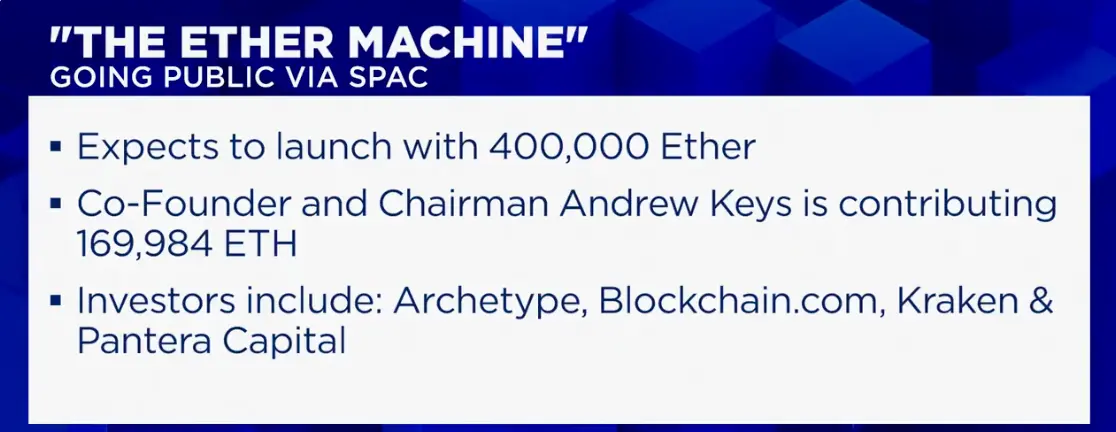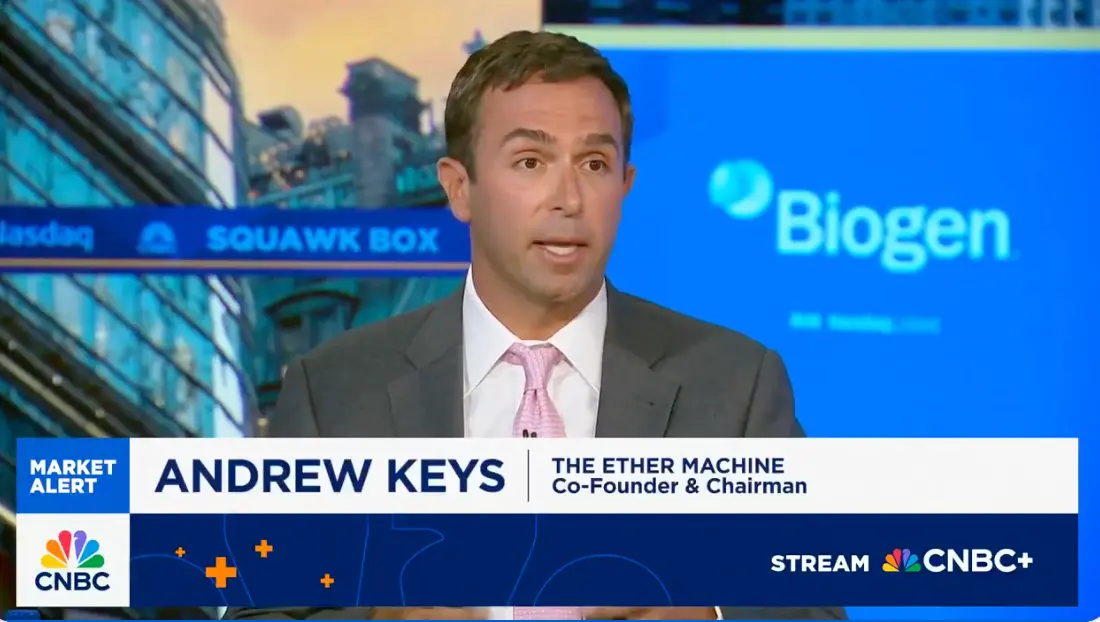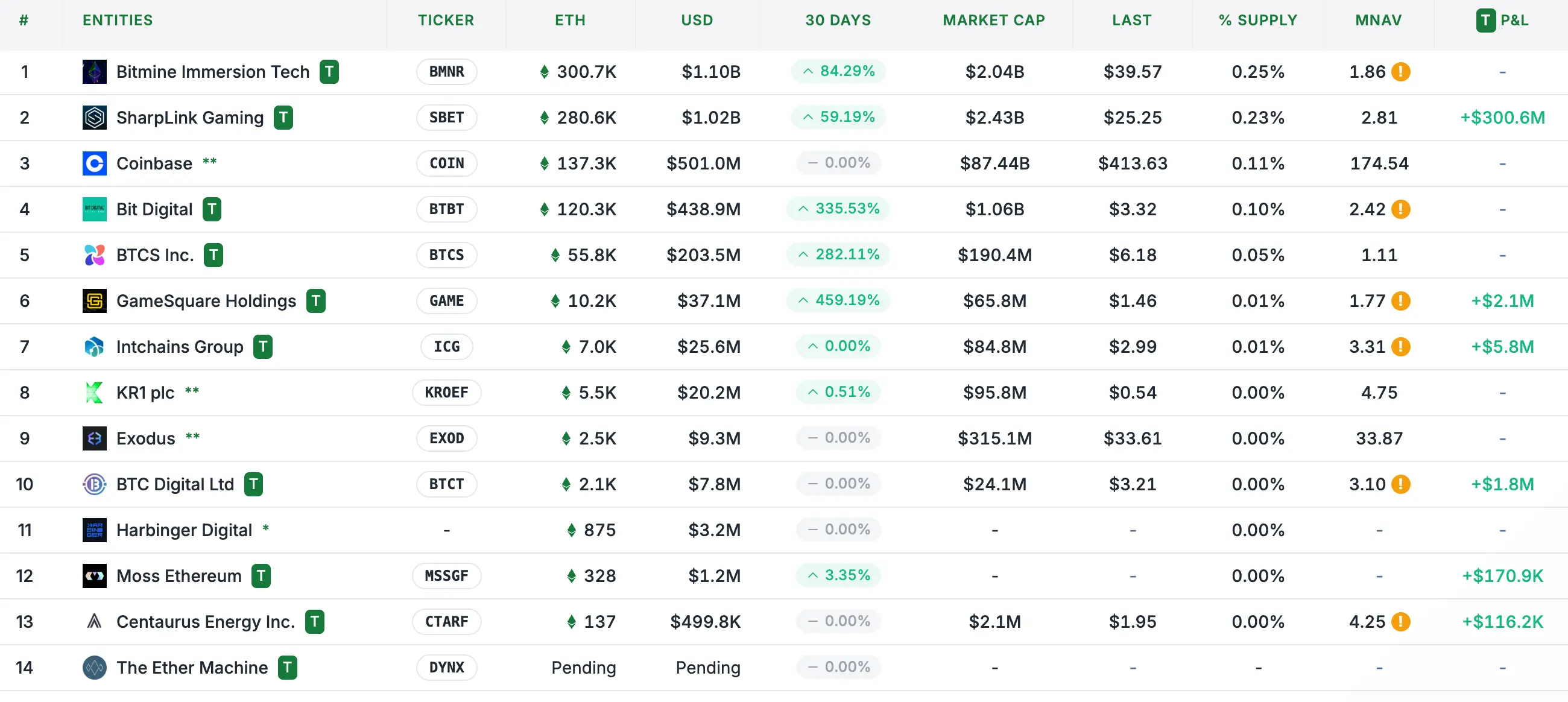
Author: Yuliya, PANews
A strong wave of capital is flowing from Wall Street to Ethereum. After Bitcoin was dubbed 'digital gold' and became a regular on some public companies' balance sheets, Ethereum is rapidly rising as 'digital oil' in the eyes of institutional investors, thanks to its unique profitability and ecosystem value, marking a new chapter in corporate strategic reserves.
From established mining firms transitioning to emerging tech companies entering the fray, an 'arms race' surrounding Ethereum has begun.
'Ether Machine' emerges.
Recently, a new company called 'Ether Machine' created by several early Ethereum builders and financial veterans announced plans to go public on Nasdaq through a merger with the blank check company Dynamix (Nasdaq code: DYNX), with the stock ticker 'ETHM'.

According to the announcement, Ether Machine plans to hold over 400,000 Ethereum at the time of listing, with a total value exceeding $1.5 billion. This substantial funding comes from two main parts:
First, the company's co-founder and chairman Andrew Keys invested approximately $645 million as cornerstone investment;
Second, they secured over $800 million in common stock financing from top crypto-native and institutional investors, including Pantera Capital, Kraken, Blockchain.com, and Electric Capital.
Unlike previous companies that simply imitated MicroStrategy's accumulation of Bitcoin, Ether Machine positions itself as more than just a passive asset holder. It defines itself as an 'active ETH generating company,' aiming to provide investors with safe, compliant, and transparent ETH-denominated returns through specialized operations. Its core strategies include:
Staking and re-staking: Utilizing its large ETH reserves to participate in the security validation of the Ethereum network to earn stable staking rewards.
DeFi strategies: Participating in well-tested DeFi protocols under strict risk assessment to obtain additional treasury returns.
Ecosystem catalysis and infrastructure development: The company plans to actively support Ethereum-native projects and provide infrastructure solutions such as validator management and block construction for institutions, deeply integrating and promoting the development of the Ethereum ecosystem.
The core team of Ether Machine can be called the 'Avengers of Ethereum.'
Chairman Andrew Keys is an early core member of ConsenSys, having led the creation of the world's largest open-source blockchain alliance, the 'Enterprise Ethereum Alliance' (EEA), and helped ETH break the $1 transaction price in 2015. CEO David Merin previously managed corporate development at ConsenSys, leading over $700 million in financing and several strategic investments. Chief Technology Officer Tim Lowe has extensive experience in Ethereum staking and blockchain infrastructure, having been responsible for developing early institutional staking platforms and enterprise blockchain projects at DARMA Capital and Consensys. DeFi head Darius Przydzial is an expert in DeFi and Ethereum infrastructure, having advised several top DeFi protocols and accumulated over a decade of quantitative research experience at traditional financial institutions like JPMorgan. Additionally, Vice Chairman Jonathan Christodoro has over 20 years of investment management experience, having worked at companies like Icahn Capital and currently serving on PayPal's board.

Andrew Keys stated in a CNBC interview: 'The biggest beneficiary of the GENIUS Act (U.S. stablecoin regulation bill) is Ethereum, as 90% of RWA and stablecoins are deployed on Ethereum, similar to how 90% of searches in the market occur on Google, while Yahoo and Bing account for only a small share. Ethereum is a productive asset, unlike Bitcoin, as it can generate intrinsic returns through staking.'
Competing Titans: Major listed companies are competing to increase their Ethereum holdings.

In fact, the emergence of Ether Machine is not an isolated case; it is precisely a reflection of the current surging wave on Wall Street. Several U.S. listed companies have already moved to incorporate Ethereum into their core balance sheets, and their stock prices have experienced significant fluctuations. Companies are competing to buy ETH, wishing to outdo each other in reserve quantities, with the victor earning the title of 'Ethereum version of MicroStrategy.'
SharpLink Gaming (SBET): As a Nasdaq-listed iGaming company, SharpLink has launched an Ethereum reserve strategy with a private placement of $425 million, holding approximately 358,000 ETH, valued at over $1.2 billion, accounting for 44% of its total market capitalization. Under the influence of Ethereum co-founder Joseph Lubin, the company has nearly fully staked ETH to earn returns.
BitMine Immersion Technologies (BMNR): As a Bitcoin mining infrastructure company, BitMine recently announced its 'light asset' Ethereum reserve strategy with great fanfare. The company raised $250 million through private placement on July 8 and currently holds Ethereum and Ethereum equivalents worth over $1.12 billion. Additionally, renowned Wall Street strategist and Fundstrat co-founder Tom Lee has been appointed chairman of its board, publicly stating that BitMine will become the 'MicroStrategy of Ethereum' and predicting that ETH will break $4,000 in the short term, with potential to reach $10,000 to $15,000 by year-end.
Bit Digital (BTBT): This company, originally focused on Bitcoin mining, has recently completed an aggressive strategic transformation. The company announced it has fully transitioned to Ethereum, raising approximately $172 million through an IPO, while liquidating its Bitcoin holdings to use all proceeds for increasing its Ethereum position. This move has skyrocketed its total ETH holdings to over 120,000. The company's CEO Samir Tabar referred to Ethereum as a 'blue-chip asset reshaping the financial system.'
GameSquare Holdings (GAME): This digital media and gaming company has also joined the fray, announcing an Ethereum reserve plan of up to $250 million, with the first batch of purchases already completed. To further invest, the company plans to raise $70 million through a stock offering specifically for purchasing ETH.
BTCS Inc. (BTCS): As one of Nasdaq's earliest blockchain concept stocks, BTCS has been deeply involved in the Ethereum ecosystem since 2021. Recently, the company disclosed that its ETH and cash market value has reached $242 million and announced plans to raise another $100 million for continued ETH purchases. Its uniqueness lies in adopting a hybrid financing model, utilizing both traditional equity financing and innovatively leveraging DeFi protocols like Aave for on-chain lending to accelerate ETH accumulation.
Innovative financing pathways and potential risks.
The financing methods employed by these companies to purchase ETH also reflect a high degree of financial innovation, but they also come with significant risks.
In addition to traditional private placements (PIPE) and market price issuances (ATM), more aggressive strategies have emerged in the market. For example, Bit Digital directly sells its Bitcoin reserves for ETH; BTCS has innovatively utilized DeFi protocols like Aave to borrow stablecoins against collateral assets to purchase more ETH, achieving on-chain leveraged operations.
'The ETH MicroStrategy narrative' has undoubtedly become a powerful catalyst for stock prices. Related company stock prices have experienced several-fold or even dozens of times surges in the short term. However, this announcement-driven increase is extremely fragile. For example, SharpLink and BitMine both experienced over 70% severe pullbacks shortly after reaching historic highs. This indicates that market sentiment is highly unstable and speculative. Moreover, holding reserves of Ethereum also exposes the following risks:
Price risk: The company's asset liabilities are highly tied to ETH prices; once the market enters a bear phase, asset value will significantly decrease.
Financing risk: Highly reliant on continuous equity financing; if the market cools, financing channels may dry up and continually dilute the rights of existing shareholders.
On-chain risks: Participating in staking and DeFi can bring returns, but also introduces a series of blockchain-native risks such as smart contract vulnerabilities, node penalties, and oracle failures.
Valuation bubble: Many companies have market capitalizations far exceeding the net asset value of their held ETH, resulting in significant premiums. This premium can be maintained during market exuberance but may be rapidly erased during calm periods or bear markets.
Who will become the 'Ethereum version of MicroStrategy'?
Despite the surging trend, no company has yet emerged to dominate the Ethereum space with absolute leadership and market pricing power like MicroStrategy has in Bitcoin. The reason is that the strategic threshold for ETH is higher, and the narrative is more complex.
Simply 'buying and holding' is insufficient to encompass its potential; effectively staking, participating in DeFi, and managing on-chain risks require deeper technical and operational capabilities.
Currently, companies represented by Ether Machine, SharpLink, and BitMine, with their strong founding teams and clear strategies, have the most potential to become leaders in this field. However, they are still in the early stages and need time to prove the sustainability of their strategies and risk management capabilities.
Undoubtedly, Ethereum's 'institutional era' has arrived. From 'digital oil' to 'internet bonds,' Wall Street is attaching new value labels to Ethereum. This reserve wave led by listed companies not only injects massive capital into the market but, more importantly, is reshaping Ethereum's recognition and positioning in global capital markets.
However, investors must remain clear-headed: this is a high-risk, high-reward game. While chasing this coin-stock linkage feast, one must also be wary of the enormous volatility and deep risks lurking behind it. Although Ethereum's path to becoming a trillion-dollar network is becoming clearer, it is destined to be a thorny path filled with opportunities and challenges.


